- Hollywood Bowl
- Packages & Ticket Info
- 2024/25 Season
- Enhance Your Experience
- Getting Here
- When You're Here
- Visit for the 20th
- Digital Tickets
- Gustavo Dudamel
- Our Supporters
- Watch & Listen
- SOUND/STAGE
- In Performance
- Beckmen YOLA Center
- Learning Programs
- Engage with the Music
- Learning Resources
- Corporate Partnerships
- More Ways to Support
- LA PHIL Store

ELECTRIC FIELDS
Colburn celebrity recital, tue / nov 15, 2022 - 8:00pm.
Composed by David Chalmin and Bryce Dessner, Inspired by Compositions by Hildegard von Bingen, Barbara Strozzi and Francesca Caccini
Masks are strongly recommended for all guests. Read more about our health and safety policies .
- Director's Note: ELECTRIC FIELDS
- David CHALMIN / Bryce DESSNER, based on Hildegard of Bingen / Barbara Strozzi / Francesca Caccini
- Electric Fields (world premiere, LA Phil commission with generous support from Ellen and Arnold Zetcher)
- No Intermission
- Barbara Hannigan , soprano
- Katia and Marielle Labèque , pianos
- Netia Jones , director & designer
- Lightmap , projection design
- David Chalmin , live electronics
- Guillaume Loubère , sound engineer
Sponsored By
Media Sponsor
About this Performance
Inspired by the cosmic compositions and contemplations of medieval polymath Hildegard von Bingen, Electric Fields offers an immersive multimedia concert experience, where otherworldly music is framed by live video, lighting projections that respond to the artists, and electronic effects.
Hildegard had visions throughout her life that led to writings on celestial systems and theories of infinite connection. Channeling that spirit, Electric Fields reaches through centuries and collapses time, connecting the music Hildegard wrote in the 12th century to Baroque-era compositions of Barbara Strozzi and Francesca Caccini—all reimagined through the modern eyes and ears of David Chalmin and Bryce Dessner. The result explores the most elusive aspects of human experience: Darkness and light. Connection and isolation. The finite and infinite.
The definition-defying project is designed and directed by Netia Jones and Lightmap. Creating the sonic world for the evening are soprano Barbara Hannigan, pianists Katia and Marielle Labèque, and Chalmin on live electronics.
The world premiere commission of Electric Fields is generously underwritten by Ellen and Arnold Zetcher.
Programs, artists, dates, prices, and availability subject to change. Ticket limits may apply. All sales are final.
- Nearby Dining
- Venue Policies
- Seating Chart
- Accessibility
- Health & Safety Info
- When should I arrive?
- May I bring food or drink into the auditorium?
- What should I wear?
¿Hablas español? Visita nuestra página web en español.
© 2024 Los Angeles Philharmonic Association. All Rights Reserved.
Privacy Policy
- Moscow concerts Moscow concerts Moscow concerts See all Moscow concerts ( Change location ) Today · Next 7 days · Next 30 days
- Most popular artists worldwide
- Trending artists worldwide
- Tourbox for artists
Search for events or artists
- Sign up Log in
- Get the app
- Moscow concerts
- Change location
- Popular Artists
- Live streams
- Popular artists
Electric Fields tour dates 2024
Electric Fields is currently touring across 1 country and has 1 upcoming concert.
The final concert of the tour will be at Carriageworks in Sydney.
Currently touring across
- 🇦🇺 Australia
Upcoming concerts (1) See nearest concert
Carriageworks
Past concerts
Bartók Tavasz
Cinestar Saal 2
Cinestar Saal 5
View all past concerts
- Most popular charts
- API information
- Brand guidelines
- Community guidelines
- Terms of use
- Privacy policy
- Cookies settings
- Cookies policy
Get your tour dates seen everywhere.
- But we really hope you love us.
The stage is set for Electric Fields' Eurovision debut
Electric fields rehearsals for the 68th edition of the song contest have revealed that fred leone will share the stage on the yidaki, with the set also being illuminated by one of zaachariaha's own paintings..

Electric Fields rehearsing One Milkali (One Blood) for Australia at the Second Rehearsal of the First Semi-Final at Malmö Arena Credit: Sarah Louise Bennett/EBU

Electric Fields brings a simple, beautiful message to Sydney's World Pride anthem
Stage dressed in songlines

Here are the two mob-made paintings that won Australia's oldest art prizes
Yidaki on the world stage

Mimili to Malmö: Electric Fields 'buzzed' to share their music with the world at Eurovision
Share this with family and friends

Subscribe to the NITV Newsletter
Receive the latest indigenous news, sport, entertainment and more in your email inbox..
By subscribing, you agree to SBS’s terms of service and privacy policy including receiving email updates from SBS.
The Point: Referendum Road Trip
Tulip Festival Amsterdam
Enjoy the tulips in Holland

Share this:
- Click to share on Twitter (Opens in new window)
- Click to share on Facebook (Opens in new window)
Visit the tulip fields near Keukenhof with an electric scooter
Experience the tulip fields outside Keukenhof Gardens with an electric scooter tulip tour . The electric scooters are perfect to ride along the flower fields and see beautiful flowers, visit tulip farms and the surroundings of Keukenhof Gardens . Are you ready to start your adventure? This self guided scooter tour starts from Noordwijk (10 km from Keukenhof).

You can decide the time hour of the tour when booking. There is a 2-hour morning tour , a 3-hour afternoon tour and an all-day tour (until 5pm). The full-day tour is perfect for combining the tour with a visit to Keukenhof Gardens or a tulip farms and show gardens. The electric scooter is noiseless and very easy to ride.
Book your Tulip Scooter Tour

Whats included with the scooter tour:
- A fully charged electric scooter
- Self guided tulip route for your mobile phone
- The tulip route passes great photo locations
- free scooter insurance
What you need to drive your electric scooter
- The scooter is for 1 person. No children can ride on the back
- No alcohol allowed
- Upon presentation of valid ID and (scooter) driving license.
- Age – from 16 years and older
- On the full-day tour, you will have time to visit e.g. Keukenhof or another tulip attraction (note: tickets for attractions are not included in the scooter tour)
Price electric scooter tulip tour
The tulip fields scooter tour is available from 21 March to 12 May 2024 . In high season the tours sell out fast so book your tour in time!
The price of the electric scooter tour depends on the tour chosen.
Start location 10 kilometres from Keukenhof
The scooter tour starts at about 10 kilometres from Keukenhof . The starting address is: Hotel NH Conference Centre Leeuwenhorst in Noordwijk. You can park for free at the start location and a bus stop can be found at a 2 minute walk. From the start location you drive directly along the flower fields.
Check out this sightseeing tours
Discover the flower fields near Keukenhof Gardens with this unique sightseeing tours along the flowers .
- Self guided bike tours »
- Guided bike tour »
- Helicopter tour »
- Renault Twizy tour »
- Boat trip at Keukenhof »
Popular links
Are you planning to visit the best (flower) activities in Holland? Make sure to check out the most populair activities:
- Everything you want to know about Keukenhof Gardens
- Check out our information about the Flower Parade in Holland
- Our top sightseeing tours for exploring the flower fields
- Buy Keukenhof quality tulip bulbs online and create your own tulip garden
- Check out our hotel tips for visiting Keukenhof and the tulip fields
- Stay informed about the blooming of the flowers in Holland with our free Flower Forecast
- Want to experience the real thing? Visit a tulip farm in Holland
- See the best flower events during your visit to Holland? Check it out in our events calendar
- Our tips for the most populair tours in Amsterdam during your stay in Holland
- Get the most out of your visit with our tips for visiting Amsterdam
- Read more about the Tulip Festival Card

About This Site
Tulip Festival Amsterdam is all about the flower events in Holland . Read our tips for visiting Keukenhof Gardens , Flower Parade , Flower Farms , Amsterdam and our Flower reports about the growth of the flower fields.
If you have any questions please feel free to contact us .
Sign up for our newsletter
Email address:
- Skip to content
- Accessibility
- Buy Tickets

Live Nation Presents
Jeff lynne's elo, the over and out tour.
- Event Starts 8:00PM
VIP PACKAGES CANNOT BE RESOLD OR TRANSFERRED. ALL PACKAGE ELEMENTS WILL BE RENDERED INVALID IF RESOLD OR TRANSFERRED
- One reserved ticket in rows 6-15 on the floor
- Green screen photo booth experience
- Light appetizers and desert bar
- (2) drink tickets per person for beer, wine, and soft drinks
- Photo opportunity in front of the VIP backdrop to commemorate you evening *
- Specially designed merchandise – exclusive to VIP packages
- Commemorative laminate and branded lanyard
- Priority entry for crowd free merchandise shopping
*No artist interaction with this package
- One reserved ticket in rows 1-5 on the floor
- Limited edition, city specific tour poster
- One reserved floor seat
Event Details
Jeff Lynne’s ELO is set to embark on the band’s final tour dubbed “The Over and Out Tour.” The 27-date trek, produced by Live Nation, will land at Rocket Mortgage FieldHouse in Cleveland, OH, on September 14, 2024.
Artist Presale will begin on Wednesday, March 20 at 10 a.m. and the general on-sale will start on Friday, March 22 at 10 a.m. Exclusive VIP experiences will be available on March 20 at 10 a.m. Please visit jefflynneselo.com for all details.
Lynne’s North American tour in 2019 delighted massive crowds and drew widespread critical acclaim:
“A brilliant catalog returns to U.S. stages and gives the strings-starved people what they want. The ELO catalog speaks for itself… and it was a glorious thing to behold… in a 19-song set that reprised the closest thing to truly Beatle-level pop the 1970s had to offer.” Variety
“Jeff Lynne’s ELO prove that spacy pop rock is still a livin’ thing… one of the most flawless and visually stunning arena shows I've seen in a long time. Complete with monstrous lights, lasers and the mandatory ELO spaceship hovering behind the band on video screens, the show was as grand and engrossing as a blockbuster movie — a ’70s blockbuster movie, that is.” LA Weekly
“Jeff Lynne and the Electric Light Orchestra put on a dazzling display chronicling a war chest of classic rock hits for a sold out crowd.” Martinez Tribune
“Jeff Lynne’s ELO is practically a religious experience for rock ‘n’ roll disciples” Houston Press
“For all the gifted musicians that helped achieve Lynne's perfectionist vision, ELO was always his creation, a neon-hued Frankenstein's monster built from bits of early rock-and-roll, symphonic themes, Beatles harmonies, and disco beats. All of those pieces came together flawlessly… played to perfection.” The Philadelphia Inquirer
Known as one of the most iconic forces in music history, in recent years Jeff Lynne’s ELO has delivered a critically acclaimed and chart-topping album along with a sold out run of UK and European shows. Jeff Lynne was inducted into the Songwriters Hall of Fame last year and the band was inducted into the Rock and Roll Hall of Fame in 2017. The band has always been known for their epic live shows and with a distinct style that seamlessly and innovatively blends rock, pop and classical, ELO has had more than 20 Top 40 Hits across the U.S. and the U.K., making Lynne's sweeping productions some of the most recognizable music of the last forty years and helping sell over 50 million records worldwide.
Widely agreed upon as one of the greatest record producers in music history, Lynne was a co-founder and member of The Travelling Wilburys together with George Harrison, Bob Dylan, Roy Orbison, and Tom Petty, as well as a producer and collaborator with some of the biggest names in music including The Beatles, Tom Petty, Roy Orbison, Paul McCartney, Ringo Starr, Joe Walsh and Bryan Adams.
Plan Your Visit
Get Directions
PLEASE NOTE: Protecting the health and safety of all our guests, staff members, and performers remains a top priority. Rocket Mortgage FieldHouse is equipped with state-of-the-art technologies and systems designed to keep you healthy, safe, and comfortable during your visit.
At this time, masks are no longer required to be worn while inside Rocket Mortgage FieldHouse. We ask all fans to be respectful of each other’s personal preferences related to individual mask wearing.
View All Security Policies

LA indie music blog,reviews,free concert tickets,mp3s

Electric Fields Promises a Night of Musical Mysticism at the Walt Disney Concert Hall on Nov. 15
The Walt Disney Concert Hall will play host to a stunning and illuminating night of music when Electric Fields begins on Tuesday, Nov. 15. Promising to be sensory immersive and multimedia concert experience, the event will seek to bridge the centuries long gap between the medieval compositions of Hildegard von Bingen with that of baroque […]

The Walt Disney Concert Hall will play host to a stunning and illuminating night of music when Electric Fields begins on Tuesday, Nov. 15. Promising to be sensory immersive and multimedia concert experience, the event will seek to bridge the centuries long gap between the medieval compositions of Hildegard von Bingen with that of baroque and modern reimaginings. The show starts at 8 PM (PST) with tickets ranging from $20-$125.
This post may contain affiliate links. Ads and affiliate links are how independent blogs like Grimy Goods can operate and pay our staff. Thank you for supporting our work and being a part of our music community.
As a composer, mystic, philosopher, and poet, the mind of Hildegard von Bingen is an ecstatic setting from which to draw inspiration. Her visions often brought her impressions of a celestial world, but her writings of them continue to echo in both modern explorations of mathematics/physics and the perpetual struggle against human suffering. But Electric Fields only uses Hildegard as a starting point, funneling her etherealness through time to connect with compositions from other periods.
As director Netia Jones puts it, the show was built around this idea of “eternal recurrence.” In looking back at Hildegard and the many other artists involved in creating and recreating compositions for Electric Fields, there’s a goal of finding some anchoring gestalt amongst us as people, regardless of our far flung separations in time and space.
Like that of Renaissance composers Barbara Strozzi and Francesca Caccini , all the way to modern times. On this end of history, musicians Bryce Dessner and David Chalmin , seek to continue that connection with no less visionary exploration via live electronics. Round out the group with soprano Barbara Hannigan and pianists Katia and Marielle Labèque and you’ve got a recipe for a night of music with immense artistic and historical weight behind it.

Don’t miss out on what’s no doubt going to be an enchanting night of otherworldly music at Electric Fields . Tickets are on sale now from $20-$125 . And be sure to check out the other amazing shows coming up at the Walt Disney Concert Hall, including Rock My Soul , Symphonies for Youth: Rock My Soul , Home Alone in Concert , New Year’s Eve with The Roots , and Kodo .

Related posts

Electric Fields tickets
Looks like we don't have any upcoming shows for electric fields.
Check out Electronic events similar to Electric Fields
Can't make it to see Electric Fields?
Sell your tickets for cash on Tixel
Frequently asked questions
Why fans love tixel.
Drive it yourself electric Dune & Summer Flower GPS audio tour

- A fully charged electric Renault Twizy suitable for 2 people.
- GPS navigation in English and German with a 30km fixed route through the Flower Bulb Region
- A fixed GPS route with stops at the largest summer flower show gardens of Europe
- Audio guide in Dutch, English and German with all ins and outs about the famous flower bulb region
- Including enough time to stop and admire & photograph the flowers up close.
- Meer en Duin 44, 2163 HC Lisse, Netherlands We are located within 2 minutes walking distance at the bus stop. You can see our Renzy.nl signage on the outside.
- Not wheelchair accessible
- Stroller accessible
- Near public transportation
- Infant seats available
- Confirmation will be received at time of booking
- Not recommended for travelers with back problems
- Not recommended for pregnant travelers
- No heart problems or other serious medical conditions
- Most travelers can participate
- Renzy is easy accessible by public transport from Amsterdam and Schiphol Airport
- At least 3 years in possession of a driver's license, age from 21 years old
- Please bring your passport or ID and driver's license
- If you are not from Europe, North America, South America or Australia, please bring an international driver's license if you do not have a driver's license in English writing
- If there is a second driver, make sure he/she also brings a passport or ID and driver's license
- Deposit payment in advance of €150,- per vehicle (credit card/pin & refund pin/cash)
- Own risk of €500,- per reserved vehicle
- Vehicles have a all-risk insurance, including passenger and 3rd party insurance
- This is a private tour/activity. Only your group will participate
- For a full refund, cancel at least 24 hours in advance of the start date of the experience.
- Keukenhof Castle

Similar experiences

- You'll start at Meer en Duin 44 Meer en Duin 44, 2163 HC Lisse, Netherlands We are located within 2 minutes walking distance at the bus stop. You can see our Renzy.nl signage on the outside. See address & details
- Pass by Renzy
- 1 De Tulperij Stop: 30 minutes See details Pass by The Flower Bulb Region
- 2 Keukenhof Castle Stop: 30 minutes See details Pass by Keukenhof
- You'll return to the starting point

- ChrisW421 0 contributions 5.0 of 5 bubbles Highlight of our day in Lisse - better than Kuekenhof. Our family of 4 including college age son and daughter did the tulip fields tour. Unfortunately the tulips were mostly gone by May 5th when we went. Still, each of us were glad we had our own vehicle. It adds up to over $500 with VAT for 4 people so I considered 2 people per vehicle, but it would not have been nearly as fun with one person cramped in the tiny back seat and the driver having all the fun. We all had a blast. The little back road streets and villages were really cool too. Definitely a highlight of our trip. We bought the bus ticket and entrance to Kuekenhof the same day. Used the bus to get out there, walked to Renzy (easy 3/4 mile walk) and then went into Kuekenhof after our drive. The Renzy buggies were way better than Kuekenhof park - which is beautiful. Read more Written May 6, 2024
- H5155WBdavidp 0 contributions 5.0 of 5 bubbles An experience you won't get anywhere else If you're considering doing the tour, stop thinking and book. The electric Twizzys are a blast to drive and everything you need to know is explained quickly and clearly. You're on the road in no time and the navigation and audio guide make the driving experience a breeze even for those not used to driving on the right. We went at the start of May which meant that the were less Tulips in the fields but we had so much fun driving the cars that it more than made up for it. Plus the included entry to the Tulip Experience Amsterdam meant that we still got our flower experience and photos. Read more Written May 6, 2024
- saveroom4dessert 0 contributions 5.0 of 5 bubbles Well organized! Very well organized! The Preplaned GPS self guided tour was very helpful. Beautiful sites along the way. You will not be disappointed. Read more Written May 4, 2024
- le0ntinem 0 contributions 5.0 of 5 bubbles Best way to see the tulips🌷 Amazing experience. What a wonderful way to see the tulip fields. Whizz by all of the cars and buses waiting to get into the gardens. Lots of time to stop and take pictures, visit a tulip farm and take a coffee break. Would 100% recommend. Read more Written May 4, 2024
- jenniferhY7848AB 0 contributions 5.0 of 5 bubbles Great Experience! This is the second time we've done this tour, and we loved it. It's so much better than driving a car bc the Twizies are so small you can pull off anywhere and not risk being in the way. Easy to maneuver on the narrow streets filled with bikes. Better then riding a bike if you don't have the stamina or ability to bike the 25k or more it takes to see all the fields. The Twizy is easy to drive and the gps is simple to follow. The screen is very readable and supported by audio which was very helpful. The back seat might be a little tricky to get in and out of if you're a bigger person or an older person. Not an insurmountable task, just takes a little work. This last time I took the tour, my 81 yo mother sat in the rear, so it is doable for sure, just a little cumbersome. They provide blankets for cushioning in the seats or if it's a little colder. Do bundle up if it's a cold day because it gets breezy at top speeds. Our stop midway at the De Tulperij was just lovely. We got a delicious, sweet treat, a coffee and some nice souvenirs. There is a nice, clean bathroom there as well if you need a pit stop midway. I highly recommend this tour for people of all ages. Read more Written May 3, 2024
- Jlcampbell17 0 contributions 5.0 of 5 bubbles The BEST countryside tulip tour! The trip was A+++ from beginning to end. Dennis and team made sure we were safe, equipped and well taken care of. So much better than a bus or tour. They go the extra mile (or km for non US ;) folks! I will come back and do the coast AND castles. A real bargain! Read more Written April 30, 2024
- ronnieg730 0 contributions 5.0 of 5 bubbles Best way to see the Tulips. This is the only way to see the Tulips in my opinion! My wife and I had a great time on the two hr tour. The car is so easy to use and the navigation works perfect. Nothing to worry about at all. They also gave us tickets to The Tulip Experience which was an amazing bonus that I didn’t know about. If you want pictures, this is the place to go. We met a couple that was on bicycles and they said they wished they rented the electric car also. The bikes looked fun but they were completely wore out and sweaty when they were half way finished. We took our time and were able to stop at every amazing farm at our own pace and take as many pictures as we wanted. Read more Written April 30, 2024
- P9281EQpaulg 0 contributions 5.0 of 5 bubbles Tulip fields in April A real adventure for us. The staff was very helpful and we had a great time. We saw lots of tulips but people need to be advised that all of the tulips in the fields could have been headed and I would make sure people understand that the weather can cold windy and rainy despite the advertising photos of clear blue skies. Read more Written April 29, 2024
- E9725HMmicheleMW 0 contributions 4.0 of 5 bubbles (NOT) Tiptoeing Through The Tulips The tour was fun in spite of cold, windy and rainy weather. Hubby loves to drive vehicles, so he was happy. I liked that we could stop anywhere to see site or take photos. Read more Written April 23, 2024
- ColoradoTraveler75 0 contributions 5.0 of 5 bubbles Great tour with Renzy Our Renzy tour of the tulips in their electric Twizys was an absolutely GREAT. We toured on a crowded Sunday afternoon, but our two Twizys were ideal for navigating the car and bike traffic efficiently and safely for our party of 4 medium-sized adults. The open-air nature of the Twizy let us enjoy the sun, sites, and smells of the gorgeous fields of flowers. The audio tour provided history and fun facts about these wonderful flowers. And, the Renzy tour route took us through the farm district giving us a great sense of life with tulip fields today. To top it off the Renzy team did a great job hosting us. I highly recommend this unique way to for enjoy the tulips and other sites of North Holland. Read more Written April 21, 2024
- PSquaredNYC 0 contributions 5.0 of 5 bubbles Fun Among the Tulips This was a fun way to get around the tulip fields, even on a cold, rainy day. I did not understand that I was renting 2 cars when I signed up and said there were 2 of us going. So just be a little cautious when booking. The staff was very friendly and the car was super easy to drive. I highly recommend it! Read more Written April 21, 2024
- BobLindaF 0 contributions 5.0 of 5 bubbles Renzy Fans! Very fun once in a lifetime experience! First, let me say Dennis was very good to us. We had originally planned this trip 4 years ago, then Covid hit and yet he still honored the credit voucher, which we really appreciated. The woman who checked us in couldn't have been nicer! She even took our picture! The automated, narrated, GPS tour was easy to follow, (although driving was a little bit hectic avoiding oncoming traffic and bikes on both sides of you) but it was fun to see the gorgeous tulip fields up close. You could stop briefly anywhere along the route and get back in again and pick up where you left off. It was an awesome experience that we highly recommend! Read more Written April 20, 2024
- LDonna Y 0 contributions 5.0 of 5 bubbles Very fun!! Do it! One of the funnest things we did in Amsterdam! We were 3 adults and we each got our own car. They were easy and fun to drive. The guides gave instructions before you took off. Great way to see the tulips. We stopped several times and got out to take pictures. The gps guided you, so you didn’t get lost. It even told you when you were 1/2 way thru the trip. There was an information recoding that gave some interesting facts about tulips. It was short which was nice. Not continuous. 2 hours was plenty of time to see lots of tulips and stop at the tulip farm. Read more Written April 19, 2024
- HangingWithMyGnomies 0 contributions 5.0 of 5 bubbles Highlight of the trip! I can’t speak highly enough about this tour. It was so much fun driving around in the Renzy car. The tulips were in full bloom and gorgeous! They are a little tricky to get in and out of, which is to be expected due to their size. We had to adjust the seat everytime we got in or out to allow space. A big thank you to the gentlemen that checked us in; we didn’t arrive the 20 minutes before the appointment as recommended, due to making the mistake of getting on the wrong bus. He said it was fine and added an extra 15 minutes to our time. We ended up back 30 minutes early anyway, but that was really appreciated. Highly recommend! Read more Written April 18, 2024
- 909sherih 0 contributions 5.0 of 5 bubbles Very fun experience. It was really fun. We saw lots of tulip fields in bloom. The audio guide was infomative and the directions were easy to follow. We did have to drive in traffic more than expected. As an adults passenger it is hard to get in and out of the vehicle. I was able to snap pictures from the back as we drove by the beautiful fields. Read more Written April 11, 2024
More to explore in Lisse

Most Recent: Reviews ordered by most recent publish date in descending order.
Detailed Reviews: Reviews ordered by recency and descriptiveness of user-identified themes such as wait time, length of visit, general tips, and location information.
Buy it with

Drive it yourself electric Dune & Summer Flower GPS audio tour provided by Renzy
5.4 Electric Field
Learning objectives.
By the end of this section, you will be able to:
- Explain the purpose of the electric field concept
- Describe the properties of the electric field
- Calculate the field of a collection of source charges of either sign
As we showed in the preceding section, the net electric force on a test charge is the vector sum of all the electric forces acting on it, from all of the various source charges, located at their various positions. But what if we use a different test charge, one with a different magnitude, or sign, or both? Or suppose we have a dozen different test charges we wish to try at the same location? We would have to calculate the sum of the forces from scratch. Fortunately, it is possible to define a quantity, called the electric field , which is independent of the test charge. It only depends on the configuration of the source charges, and once found, allows us to calculate the force on any test charge.
Defining a Field
Suppose we have N source charges q 1 , q 2 , q 3 ,… , q N q 1 , q 2 , q 3 ,… , q N , applying N electrostatic forces on a test charge Q , at displacements r → 1 , r → 2 , r → 3 ,… , r → N r → 1 , r → 2 , r → 3 ,… , r → N from the source charges. The net force on Q is (see Equation 5.2 )
We can rewrite this as
or, more compactly,
This expression is called the electric field at position P = P ( x , y , z ) P = P ( x , y , z ) of the N source charges. Here, P is the location of the point in space where you are calculating the field and the vectors r → i r → i are the displacements from each source to the test point ( Figure 5.18 ). Note that we have to impose a coordinate system to solve actual problems.
Notice that the calculation of the electric field makes no reference to the test charge. Thus, the physically useful approach is to calculate the electric field and then use it to calculate the force on some test charge later, if needed. Different test charges experience different forces Equation 5.3 , but it is the same electric field Equation 5.4 . That being said, recall that there is no fundamental difference between a test charge and a source charge; these are merely convenient labels for the system of interest. Any charge produces an electric field; however, just as Earth’s orbit is not affected by Earth’s own gravity, a charge is not subject to a force due to the electric field it generates. Charges are only subject to forces from the electric fields of other charges.
In this respect, the electric field E → E → of a point charge is similar to the gravitational field g → g → of Earth; once we have calculated the gravitational field at some point in space, we can use it any time we want to calculate the resulting force on any mass we choose to place at that point. In fact, this is exactly what we do when we say the gravitational field of Earth (near Earth’s surface) has a value of 9.81 m/s 2 , 9.81 m/s 2 , and then we calculate the resulting force (i.e., weight) on different masses. Also, the general expression for calculating g → g → at arbitrary distances from the center of Earth (i.e., not just near Earth’s surface) is very similar to the expression for E → E → : g → = G M r 2 r ^ g → = G M r 2 r ^ , where G is a proportionality constant, playing the same role for g → g → as 1 4 π ε 0 1 4 π ε 0 does for E → E → . The value of g → g → is calculated once and is then used in an endless number of problems.
To push the analogy further, notice the units of the electric field: From F = Q E F = Q E , the units of E are newtons per coulomb, N/C, that is, the electric field applies a force on each unit charge. Now notice the units of g : From w = m g w = m g , the units of g are newtons per kilogram, N/kg, that is, the gravitational field applies a force on each unit mass. We could say that the gravitational field of Earth, near Earth’s surface, has a value of 9.81 N/kg.
The Meaning of “Field”
Recall from your studies of gravity that the word “field” in this context has a precise meaning. A field, in physics, is a physical quantity whose value depends on (is a function of) position, relative to the source of the field. In the case of the electric field, Equation 5.4 shows that the value of E → E → (both the magnitude and the direction) depends on where in space the point P is located, with r → i r → i measured from the locations of the source charges q i q i .
In addition, since the electric field is a vector quantity, the electric field is referred to as a vector field . (The gravitational field is also a vector field.) In contrast, a field that has only a magnitude at every point is a scalar field . The temperature in a room is an example of a scalar field. It is a field because the temperature, in general, is different at different locations in the room, and it is a scalar field because temperature is a scalar quantity.
Also, as you did with the gravitational field of an object with mass, you should picture the electric field of a charge-bearing object (the source charge) as a continuous, immaterial substance that surrounds the source charge, filling all of space—in principle, to ± ∞ ± ∞ in all directions. The field exists at every physical point in space. To put it another way, the electric charge on an object alters the space around the charged object in such a way that all other electrically charged objects in space experience an electric force as a result of being in that field. The electric field, then, is the mechanism by which the electric properties of the source charge are transmitted to and through the rest of the universe. (Again, the range of the electric force is infinite.)
We will see in subsequent chapters that the speed at which electrical phenomena travel is the same as the speed of light. There is a deep connection between the electric field and light.
Superposition
Yet another experimental fact about the field is that it obeys the superposition principle. In this context, that means that we can (in principle) calculate the total electric field of many source charges by calculating the electric field of only q 1 q 1 at position P , then calculate the field of q 2 q 2 at P , while—and this is the crucial idea—ignoring the field of, and indeed even the existence of, q 1 . q 1 . We can repeat this process, calculating the field of each individual source charge, independently of the existence of any of the other charges. The total electric field, then, is the vector sum of all these fields. That, in essence, is what Equation 5.4 says.
In the next section, we describe how to determine the shape of an electric field of a source charge distribution and how to sketch it.
The Direction of the Field
Equation 5.4 enables us to determine the magnitude of the electric field, but we need the direction also. We use the convention that the direction of any electric field vector is the same as the direction of the electric force vector that the field would apply to a positive test charge placed in that field. Such a charge would be repelled by positive source charges (the force on it would point away from the positive source charge) but attracted to negative charges (the force points toward the negative source).
Direction of the Electric Field
By convention, all electric fields E → E → point away from positive source charges and point toward negative source charges.
Interactive
Add charges to the Electric Field of Dreams and see how they react to the electric field. Turn on a background electric field and adjust the direction and magnitude.
Example 5.3
The e -field of an atom.
Since there is only one source charge (the nucleus), this expression simplifies to
Here q = 2 e = 2 ( 1.6 × 10 −19 C ) q = 2 e = 2 ( 1.6 × 10 −19 C ) (since there are two protons) and r is given; substituting gives
The direction of E → E → is radially away from the nucleus in all directions. Why? Because a positive test charge placed in this field would accelerate radially away from the nucleus (since it is also positively charged), and again, the convention is that the direction of the electric field vector is defined in terms of the direction of the force it would apply to positive test charges.
Example 5.4
The e -field above two equal charges.
(b) The same as part (a), only this time make the right-hand charge − q − q instead of + q + q .
- If the source charges are equal and opposite, the vertical components cancel because E z = 1 4 π ε 0 q r 2 cos θ − 1 4 π ε 0 q r 2 cos θ = 0 E z = 1 4 π ε 0 q r 2 cos θ − 1 4 π ε 0 q r 2 cos θ = 0 and we get, for the horizontal component of E → E → , E → ( z ) = 1 4 π ε 0 q r 2 sin θ i ^ − 1 4 π ε 0 − q r 2 sin θ i ^ = 1 4 π ε 0 2 q r 2 sin θ i ^ = 1 4 π ε 0 2 q [ z 2 + ( d 2 ) 2 ] ( d 2 ) [ z 2 + ( d 2 ) 2 ] 1 / 2 i ^ . E → ( z ) = 1 4 π ε 0 q r 2 sin θ i ^ − 1 4 π ε 0 − q r 2 sin θ i ^ = 1 4 π ε 0 2 q r 2 sin θ i ^ = 1 4 π ε 0 2 q [ z 2 + ( d 2 ) 2 ] ( d 2 ) [ z 2 + ( d 2 ) 2 ] 1 / 2 i ^ . This becomes E → ( z ) = 1 4 π ε 0 q d [ z 2 + ( d 2 ) 2 ] 3 / 2 i ^ . E → ( z ) = 1 4 π ε 0 q d [ z 2 + ( d 2 ) 2 ] 3 / 2 i ^ . 5.6
Significance
Let’s start with Equation 5.5 , the field of two identical charges. From far away (i.e., z ≫ d ) , z ≫ d ) , the two source charges should “merge” and we should then “see” the field of just one charge, of size 2 q . So, let z ≫ d ; z ≫ d ; then we can neglect d 2 d 2 in Equation 5.5 to obtain
which is the correct expression for a field at a distance z away from a charge 2 q .
Next, we consider the field of equal and opposite charges, Equation 5.6 . It can be shown (via a Taylor expansion) that for d ≪ z ≪ ∞ d ≪ z ≪ ∞ , this becomes
which is the field of a dipole, a system that we will study in more detail later. (Note that the units of E → E → are still correct in this expression, since the units of d in the numerator cancel the unit of the “extra” z in the denominator.) If z is very large ( z → ∞ ) ( z → ∞ ) , then E → 0 E → 0 , as it should; the two charges “merge” and so cancel out.
Check Your Understanding 5.3
What is the electric field due to a single point particle?
Try this simulation of electric field hockey to get the charge in the goal by placing other charges on the field.
As an Amazon Associate we earn from qualifying purchases.
This book may not be used in the training of large language models or otherwise be ingested into large language models or generative AI offerings without OpenStax's permission.
Want to cite, share, or modify this book? This book uses the Creative Commons Attribution License and you must attribute OpenStax.
Access for free at https://openstax.org/books/university-physics-volume-2/pages/1-introduction
- Authors: Samuel J. Ling, William Moebs, Jeff Sanny
- Publisher/website: OpenStax
- Book title: University Physics Volume 2
- Publication date: Oct 6, 2016
- Location: Houston, Texas
- Book URL: https://openstax.org/books/university-physics-volume-2/pages/1-introduction
- Section URL: https://openstax.org/books/university-physics-volume-2/pages/5-4-electric-field
© Jan 19, 2024 OpenStax. Textbook content produced by OpenStax is licensed under a Creative Commons Attribution License . The OpenStax name, OpenStax logo, OpenStax book covers, OpenStax CNX name, and OpenStax CNX logo are not subject to the Creative Commons license and may not be reproduced without the prior and express written consent of Rice University.

- school Campus Bookshelves
- menu_book Bookshelves
- perm_media Learning Objects
- login Login
- how_to_reg Request Instructor Account
- hub Instructor Commons
- Download Page (PDF)
- Download Full Book (PDF)
- Periodic Table
- Physics Constants
- Scientific Calculator
- Reference & Cite
- Tools expand_more
- Readability
selected template will load here
This action is not available.

3.4: Electric Field
- Last updated
- Save as PDF
- Page ID 76515

LEARNING OBJECTIVES
By the end of this section, you will be able to:
- Explain the purpose of the electric field concept
- Describe the properties of the electric field
- Calculate the field of a collection of source charges of either sign
- Explain the purpose of an electric field diagram
- Describe the relationship between a vector diagram and a field line diagram
- Explain the rules for creating a field diagram and why these rules make physical sense
- Sketch the field of an arbitrary source charge
- Describe a permanent dipole
- Describe an induced dipole
- Define and calculate an electric dipole moment
- Explain the physical meaning of the dipole moment
As we showed in the preceding section, the net electric force on a test charge is the vector sum of all the electric forces acting on it, from all of the various source charges, located at their various positions. But what if we use a different test charge, one with a different magnitude, or sign, or both? Or suppose we have a dozen different test charges we wish to try at the same location? We would have to calculate the sum of the forces from scratch. Fortunately, it is possible to define a quantity, called the electric field , which is independent of the test charge. It only depends on the configuration of the source charges, and once found, allows us to calculate the force on any test charge.
Defining a Field
Suppose we have \(N\) source charges \(q_1, q_2, q_3, . . . q_N\) located at positions \(vec{r}_1, \vec{r}_2, \vec{r}_3, . . . \vec{r}_N\), applying \(N\) electrostatic forces on a test charge \(Q\). The net force on \(Q\) is
\[ \begin{align} \vec{F} &= \vec{F}_1 + \vec{F}_2 +\vec{F}_3 + . . . + \vec{F}_N \\[4pt] &= \dfrac{1}{4 \pi \epsilon_0}\left(\dfrac{Qq_1}{r_1^2}\hat{r}_1 + \dfrac{Qq_2}{r_2^2}\hat{r}_2 + \dfrac{Qq_3}{r_3^2}\hat{r}_3 + . . . + \dfrac{Qq_N}{r_1^2}\hat{r}_N\right) \\[4pt] &= Q\left[\dfrac{1}{4 \pi \epsilon_0}\left(\dfrac{q_1}{r_1^2}\hat{r}_1 + \dfrac{q_2}{r_2^2}\hat{r}_2 + \dfrac{q_3}{r_3^2}\hat{r}_3 + . . . + \dfrac{q_N}{r_1^2}\hat{r}_N\right)\right] \end{align}\]
We can rewrite this as
\[\vec{F} = Q \vec{E} \label{Efield1}\]
\[\vec{E} \equiv \dfrac{1}{4 \pi \epsilon_0}\left(\dfrac{q_1}{r_1^2}\hat{r}_1 + \dfrac{q_2}{r_2^2}\hat{r}_2 + \dfrac{q_3}{r_3^2}\hat{r}_3 + . . . + \dfrac{q_N}{r_1^2}\hat{r}_N\right) \label{Efield2}\]
or, more compactly,
\[\vec{E}(P) \equiv \dfrac{1}{4 \pi \epsilon_0} \sum_{i=1}^N \dfrac{q_i}{r_i^2}\hat{r}_i. \label{Efield3}\]
This expression is called the electric field at position \(P = P(x, y, z)\) of the \(N\) source charges. Here, \(P\) is the location of the point in space where you are calculating the field and is relative to the positions \(\vec{r}_i\) of the source charges (Figure \(\PageIndex{1}\)). Note that we have to impose a coordinate system to solve actual problems.
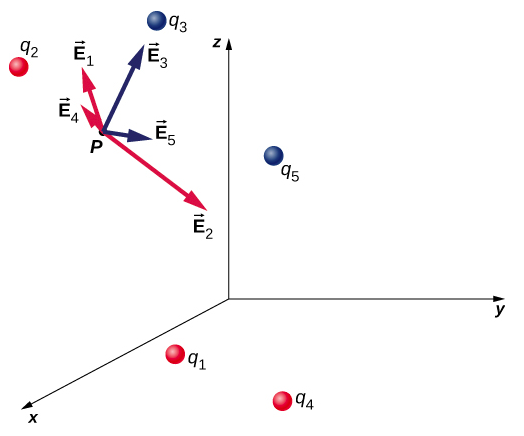
Notice that the calculation of the electric field makes no reference to the test charge. Thus, the physically useful approach is to calculate the electric field and then use it to calculate the force on some test charge later, if needed. Different test charges experience different forces Equation \ref{Efield1}, but it is the same electric field Equation \ref{Efield3}. That being said, recall that there is no fundamental difference between a test charge and a source charge; these are merely convenient labels for the system of interest. Any charge produces an electric field; however, just as Earth’s orbit is not affected by Earth’s own gravity, a charge is not subject to a force due to the electric field it generates. Charges are only subject to forces from the electric fields of other charges.
In this respect, the electric field \(\vec{E}\) of a point charge is similar to the gravitational field \(\vec{g}\) of Earth; once we have calculated the gravitational field at some point in space, we can use it any time we want to calculate the resulting force on any mass we choose to place at that point. In fact, this is exactly what we do when we say the gravitational field of Earth (near Earth’s surface) has a value of \(8.81 \, m/s^2\) and then we calculate the resulting force (i.e., weight) on different masses. Also, the general expression for calculating \(\vec{g}\) at arbitrary distances from the center of Earth (i.e., not just near Earth’s surface) is very similar to the expression for \(E\):
\[\vec{g} = G\dfrac{M}{r^2}\hat{r}\]
where \(G\) is a proportionality constant, playing the same role for \(\vec{g}\) as \(\dfrac{1}{4\pi \epsilon_0}\) does for \(\vec{E}\). The value of \(\vec{g}\) is calculated once and is then used in an endless number of problems.
To push the analogy further, notice the units of the electric field: From \(F = QE\), the units of E are newtons per coulomb, N/C, that is, the electric field applies a force on each unit charge. Now notice the units of g : From \(\omega = mg\) the units of g are newtons per kilogram, N/kg, that is, the gravitational field applies a force on each unit mass. We could say that the gravitational field of Earth, near Earth’s surface, has a value of 9.81 N/kg.
The Meaning of “Field
Recall from your studies of gravity that the word “field” in this context has a precise meaning. A field, in physics, is a physical quantity whose value depends on (is a function of) position, relative to the source of the field. In the case of the electric field, Equation \ref{Efield3} shows that the value of \(\vec{E}\) (both the magnitude and the direction) depends on where in space the point \(P\) is located, measured from the locations \(\vec{r}_i\) of the source charges \(q_i\).
In addition, since the electric field is a vector quantity, the electric field is referred to as a vector field . (The gravitational field is also a vector field.) In contrast, a field that has only a magnitude at every point is a scalar field . The temperature in a room is an example of a scalar field. It is a field because the temperature, in general, is different at different locations in the room, and it is a scalar field because temperature is a scalar quantity.
Also, as you did with the gravitational field of an object with mass, you should picture the electric field of a charge-bearing object (the source charge) as a continuous, immaterial substance that surrounds the source charge, filling all of space—in principle, to \(\pm \infty\) in all directions. The field exists at every physical point in space. To put it another way, the electric charge on an object alters the space around the charged object in such a way that all other electrically charged objects in space experience an electric force as a result of being in that field. The electric field, then, is the mechanism by which the electric properties of the source charge are transmitted to and through the rest of the universe. (Again, the range of the electric force is infinite.)
We will see in subsequent chapters that the speed at which electrical phenomena travel is the same as the speed of light. There is a deep connection between the electric field and light.
Superposition
Yet another experimental fact about the field is that it obeys the superposition principle. In this context, that means that we can (in principle) calculate the total electric field of many source charges by calculating the electric field of only \(q_1\) at position P , then calculate the field of \(q_2\) at P , while—and this is the crucial idea—ignoring the field of, and indeed even the existence of, \(q_1\). We can repeat this process, calculating the field of each individual source charge, independently of the existence of any of the other charges. The total electric field, then, is the vector sum of all these fields. That, in essence, is what Equation \ref{Efield3} says.
In the next section, we describe how to determine the shape of an electric field of a source charge distribution and how to sketch it.
The Direction of the Field
Equation \ref{Efield3} enables us to determine the magnitude of the electric field, but we need the direction also. We use the convention that the direction of any electric field vector is the same as the direction of the electric force vector that the field would apply to a positive test charge placed in that field. Such a charge would be repelled by positive source charges (the force on it would point away from the positive source charge) but attracted to negative charges (the force points toward the negative source).
Direction of the Electric Field
By convention, all electric fields \(\vec{E}\) point away from positive source charges and point toward negative source charges.
Electric Field Lines
Now that we have some experience calculating electric fields, let’s try to gain some insight into the geometry of electric fields. As mentioned earlier, our model is that the charge on an object (the source charge) alters space in the region around it in such a way that when another charged object (the test charge) is placed in that region of space, that test charge experiences an electric force. The concept of electric field line s , and of electric field line diagrams, enables us to visualize the way in which the space is altered, allowing us to visualize the field. The purpose of this section is to enable you to create sketches of this geometry, so we will list the specific steps and rules involved in creating an accurate and useful sketch of an electric field.
It is important to remember that electric fields are three-dimensional. Although in this book we include some pseudo-three-dimensional images, several of the diagrams that you’ll see (both here, and in subsequent chapters) will be two-dimensional projections, or cross-sections. Always keep in mind that in fact, you’re looking at a three-dimensional phenomenon.
Our starting point is the physical fact that the electric field of the source charge causes a test charge in that field to experience a force. By definition, electric field vectors point in the same direction as the electric force that a (hypothetical) positive test charge would experience, if placed in the field (Figure \(\PageIndex{5}\)).
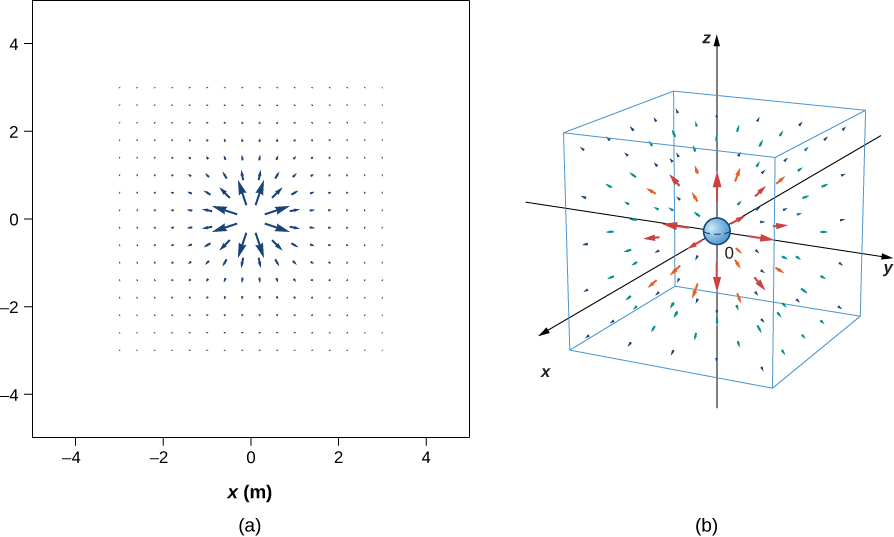
We’ve plotted many field vectors in the figure, which are distributed uniformly around the source charge. Since the electric field is a vector, the arrows that we draw correspond at every point in space to both the magnitude and the direction of the field at that point. As always, the length of the arrow that we draw corresponds to the magnitude of the field vector at that point. For a point source charge, the length decreases by the square of the distance from the source charge. In addition, the direction of the field vector is radially away from the source charge, because the direction of the electric field is defined by the direction of the force that a positive test charge would experience in that field. (Again, keep in mind that the actual field is three-dimensional; there are also field lines pointing out of and into the page.)
This diagram is correct, but it becomes less useful as the source charge distribution becomes more complicated. For example, consider the vector field diagram of a dipole (Figure \(\PageIndex{6}\)).
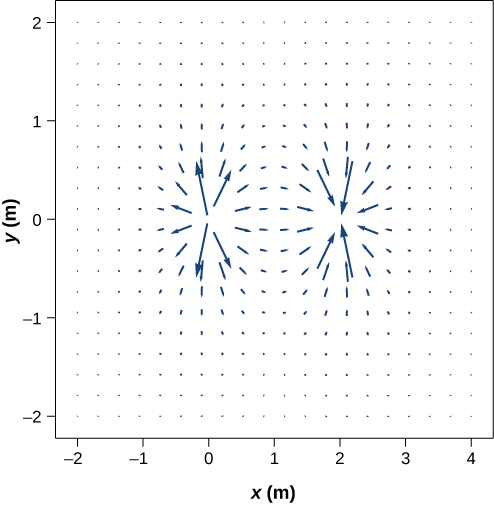
There is a more useful way to present the same information. Rather than drawing a large number of increasingly smaller vector arrows, we instead connect all of them together, forming continuous lines and curves, as shown in Figure \(\PageIndex{7}\).

Although it may not be obvious at first glance, these field diagrams convey the same information about the electric field as do the vector diagrams. First, the direction of the field at every point is simply the direction of the field vector at that same point. In other words, at any point in space, the field vector at each point is tangent to the field line at that same point. The arrowhead placed on a field line indicates its direction.
As for the magnitude of the field, that is indicated by the field line density —that is, the number of field lines per unit area passing through a small cross-sectional area perpendicular to the electric field. This field line density is drawn to be proportional to the magnitude of the field at that cross-section. As a result, if the field lines are close together (that is, the field line density is greater), this indicates that the magnitude of the field is large at that point. If the field lines are far apart at the cross-section, this indicates the magnitude of the field is small. Figure \(\PageIndex{8}\) shows the idea.
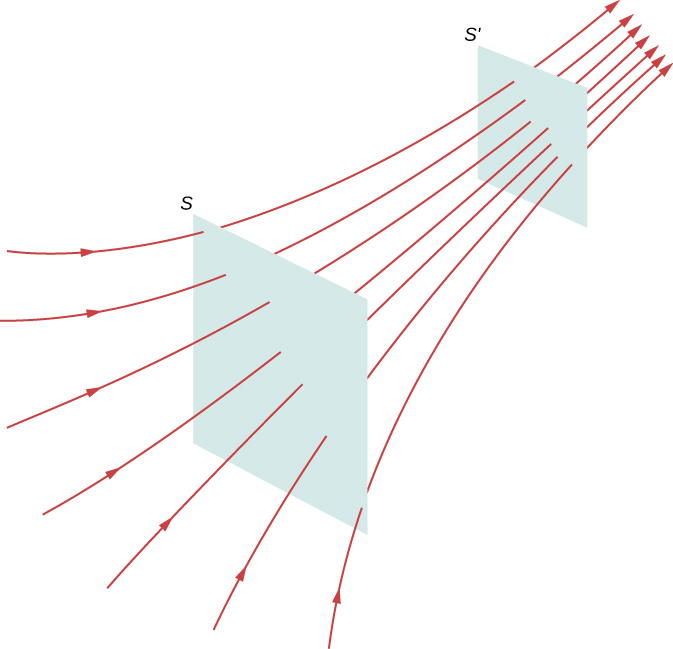
In Figure \(\PageIndex{8}\), the same number of field lines passes through both surfaces ( S and \(S'\)), but the surface S is larger than surface \(S'\). Therefore, the density of field lines (number of lines per unit area) is larger at the location of \(S'\), indicating that the electric field is stronger at the location of \(S'\) than at S . The rules for creating an electric field diagram are as follows.
Problem-Solving Strategy: Drawing Electric Field Lines
- Electric field lines either originate on positive charges or come in from infinity, and either terminate on negative charges or extend out to infinity.
- The number of field lines originating or terminating at a charge is proportional to the magnitude of that charge. A charge of 2 q will have twice as many lines as a charge of q .
- At every point in space, the field vector at that point is tangent to the field line at that same point.
- The field line density at any point in space is proportional to (and therefore is representative of) the magnitude of the field at that point in space.
- Field lines can never cross. Since a field line represents the direction of the field at a given point, if two field lines crossed at some point, that would imply that the electric field was pointing in two different directions at a single point. This in turn would suggest that the (net) force on a test charge placed at that point would point in two different directions. Since this is obviously impossible, it follows that field lines must never cross.
Always keep in mind that field lines serve only as a convenient way to visualize the electric field; they are not physical entities. Although the direction and relative intensity of the electric field can be deduced from a set of field lines, the lines can also be misleading. For example, the field lines drawn to represent the electric field in a region must, by necessity, be discrete. However, the actual electric field in that region exists at every point in space.
Field lines for three groups of discrete charges are shown in Figure \(\PageIndex{9}\). Since the charges in parts (a) and (b) have the same magnitude, the same number of field lines are shown starting from or terminating on each charge. In (c), however, we draw three times as many field lines leaving the \(+3q\) charge as entering the \(-q\). The field lines that do not terminate at \(-q\) emanate outward from the charge configuration, to infinity.
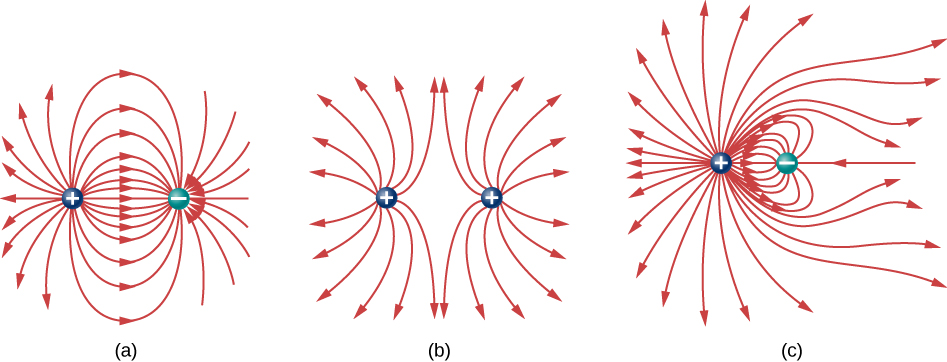
The ability to construct an accurate electric field diagram is an important, useful skill; it makes it much easier to estimate, predict, and therefore calculate the electric field of a source charge. The best way to develop this skill is with software that allows you to place source charges and then will draw the net field upon request. We strongly urge you to search the Internet for a program. Once you’ve found one you like, run several simulations to get the essential ideas of field diagram construction. Then practice drawing field diagrams, and checking your predictions with the computer-drawn diagrams.
Rotation of a Dipole due to an Electric Field
In example \(\PageIndex{1B}\) we discussed, and calculated, the electric field of a dipole: two equal and opposite charges that are “close” to each other. (In this context, “close” means that the distance d between the two charges is much, much less than the distance of the field point P , the location where you are calculating the field.) Let’s now consider what happens to a dipole when it is placed in an external field \(\vec{E}\). We assume that the dipole is a permanent dipole ; it exists without the field, and does not break apart in the external field.
For now, we deal with only the simplest case: The external field is uniform in space. Suppose we have the situation depicted in Figure \(\PageIndex{1}\), where we denote the distance between the charges as the vector \(\vec{d}\), pointing from the negative charge to the positive charge.

The forces on the two charges are equal and opposite, so there is no net force on the dipole. However, there is a torque:
\[\begin{align} \vec{r} &= \left(\dfrac{\vec{d}}{2} \times \vec{F}_+ \right) + \left(- \dfrac{\vec{d}}{2} \times \vec{F}_- \right) \\[4pt] &= \left[ \left(\dfrac{\vec{d}}{2}\right) \times \left(+q\vec{E}\right) + \left(-\dfrac{\vec{d}}{2}\right) \times \left(-q\vec{E}\right)\right] \\[4pt] &= q\vec{d} \times \vec{E}. \end{align}\]
The quantity \(qd\) (the magnitude of each charge multiplied by the vector distance between them) is a property of the dipole; its value, as you can see, determines the torque that the dipole experiences in the external field. It is useful, therefore, to define this product as the so-called dipole moment of the dipole:
\[\vec{p} \equiv q\vec{d}.\]
We can therefore write
\[\vec{r} = \vec{p} \times \vec{E}.\]
Recall that a torque changes the angular velocity of an object, the dipole, in this case. In this situation, the effect is to rotate the dipole (that is, align the direction of \(\vec{p}\)) so that it is parallel to the direction of the external field.
Induced Dipoles
Neutral atoms are, by definition, electrically neutral; they have equal amounts of positive and negative charge. Furthermore, since they are spherically symmetrical, they do not have a “built-in” dipole moment the way most asymmetrical molecules do. They obtain one, however, when placed in an external electric field, because the external field causes oppositely directed forces on the positive nucleus of the atom versus the negative electrons that surround the nucleus. The result is a new charge distribution of the atom, and therefore, an induced dipole moment (Figure \(\PageIndex{2}\)).
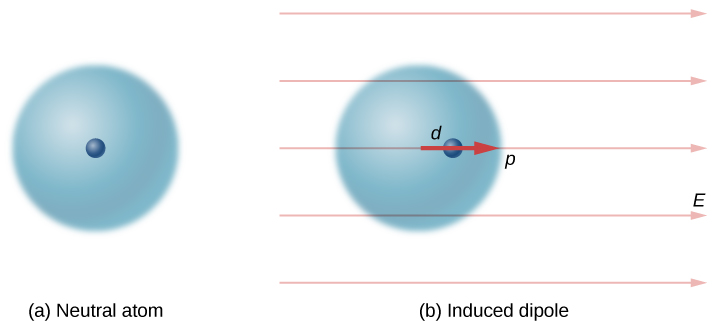
An important fact here is that, just as for a rotated polar molecule, the result is that the dipole moment ends up aligned parallel to the external electric field. Generally, the magnitude of an induced dipole is much smaller than that of an inherent dipole. For both kinds of dipoles, notice that once the alignment of the dipole (rotated or induced) is complete, the net effect is to decrease the total electric field
\[\vec{E}_{total} = \vec{E}_{external} + \vec{E}_{dipole}\]
in the regions outside the dipole charges (Figure \(\PageIndex{3}\)). By “outside” we mean further from the charges than they are from each other. This effect is crucial for capacitors, as you will see in Capacitance .
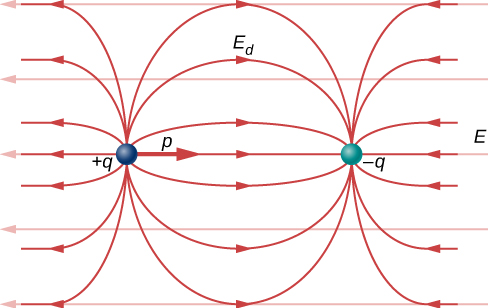
Recall that we found the electric field of a dipole in example \(\PageIndex{1B}\). If we rewrite it in terms of the dipole moment we get:
\[\vec{E}(z) = \dfrac{1}{4 \pi \epsilon_0} \dfrac{\vec{p}}{z^3}.\]
The form of this field is shown in Figure \(\PageIndex{3}\). Notice that along the plane perpendicular to the axis of the dipole and midway between the charges, the direction of the electric field is opposite that of the dipole and gets weaker the further from the axis one goes. Similarly, on the axis of the dipole (but outside it), the field points in the same direction as the dipole, again getting weaker the further one gets from the charges.
Example \(\PageIndex{1A}\): The E-field of an Atom
In an ionized helium atom, the most probable distance between the nucleus and the electron is \(r = 26.5 \times 10^{-12} m\). What is the electric field due to the nucleus at the location of the electron?
Note that although the electron is mentioned, it is not used in any calculation. The problem asks for an electric field, not a force; hence, there is only one charge involved, and the problem specifically asks for the field due to the nucleus. Thus, the electron is a red herring; only its distance matters. Also, since the distance between the two protons in the nucleus is much, much smaller than the distance of the electron from the nucleus, we can treat the two protons as a single charge +2 e (Figure \(\PageIndex{2}\)).
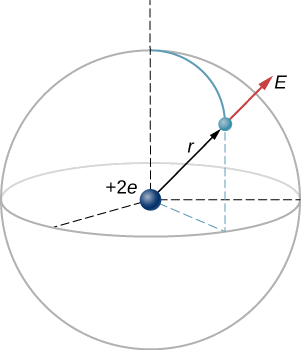
The electric field is calculated by
\[\vec{E} = \dfrac{1}{4 \pi \epsilon_0} \sum_{i=1}^N \dfrac{q_i}{r_i^2} \hat{r}_i. \nonumber\]
Since there is only one source charge (the nucleus), this expression simplifies to
\[\vec{E} = \dfrac{1}{4\pi \epsilon_0}\dfrac{q}{r^2}\hat{r}. \nonumber\]
Here, \(q = 2e = 2(1.6 \times 10^{-19} \, C)\) (since there are two protons) and r is given; substituting gives
\[ \begin{align*} \vec{E} &= \dfrac{1}{4\pi \left(8.85 \times 10^{-12} \dfrac{C^2}{N\cdot m^2}\right)} \dfrac{2(1.6 \times 10^{-19} C)}{26.5 \times 10^{-12}m)^2}\hat{r} \\[4pt] &= 4.1 \times 10^{12} \dfrac{N}{C}\hat{r}. \end{align*}\]
The direction of \(\vec{E}\) is radially away from the nucleus in all directions. Why? Because a positive test charge placed in this field would accelerate radially away from the nucleus (since it is also positively charged), and again, the convention is that the direction of the electric field vector is defined in terms of the direction of the force it would apply to positive test charges.
Example \(\PageIndex{1B}\): The E-Field above Two Equal Charges (Dipole)
- Find the electric field (magnitude and direction) a distance z above the midpoint between two equal charges \(+q\) that are a distance d apart (Figure \(\PageIndex{3}\)). Check that your result is consistent with what you’d expect when \(z \gg d\).
- The same as part (a), only this time make the right-hand charge \(-q\) instead of \(+q\).
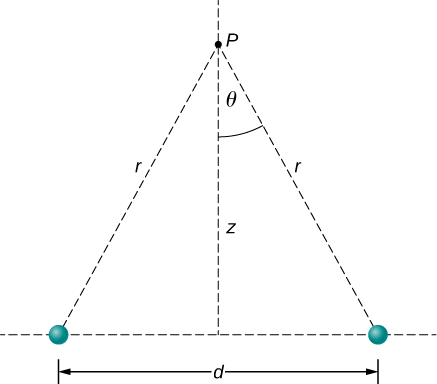
We add the two fields as vectors, per Equation \ref{Efield3}. Notice that the system (and therefore the field) is symmetrical about the vertical axis; as a result, the horizontal components of the field vectors cancel. This simplifies the math. Also, we take care to express our final answer in terms of only quantities that are given in the original statement of the problem: \(q\), \(z\), \(d\), and constants \((\pi, \epsilon_0)\).
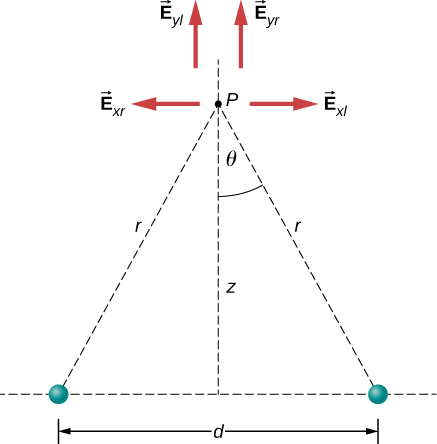
a. By symmetry, the horizontal ( x )-components of \(\vec{E}\) cancel (Figure \(\PageIndex{4}\));
\[ \begin{align*} E_x &= \dfrac{1}{4\pi \epsilon_0} \dfrac{q}{r^2} \, \sin \, \theta - \dfrac{1}{4\pi \epsilon_0} \dfrac{q}{r^2} \, \sin \, \theta \\[4pt] &= 0. \end{align*}\]
The vertical ( z )-component is given by
\[ \begin{align*} E_z &= \dfrac{1}{4\pi \epsilon_0} \dfrac{q}{r^2} \, \cos \, \theta + \dfrac{1}{4\pi \epsilon_0} \dfrac{q}{r^2} \, \cos \, \theta \\[4pt] &= \dfrac{1}{4\pi \epsilon_0} \dfrac{2q}{r^2} \, \cos \, \theta. \end{align*}\]
Since none of the other components survive, this is the entire electric field, and it points in the \(\hat{k}\) direction. Notice that this calculation uses the principle of superposition ; we calculate the fields of the two charges independently and then add them together.
What we want to do now is replace the quantities in this expression that we don’t know (such as \(r\)), or can’t easily measure (such as \(cos \, \theta\) with quantities that we do know, or can measure. In this case, by geometry,
\[r^2 = z^2 + \left(\dfrac{d}{2}\right)^2 \nonumber\]
\[\cos \, \theta = \dfrac{z}{R} = \dfrac{z}{\left[z^2 + \left(\dfrac{d}{2} \right)^2\right]^{1/2}}. \nonumber\]
Thus, substituting,
\[\vec{E}(z) = \dfrac{1}{4\pi \epsilon_0}\dfrac{2q}{\left[z^2 + \left(\dfrac{d}{2}\right)^2\right]^2} \dfrac{z}{\left[z^2 + \left(\dfrac{d}{2} \right)^2 \right]^{1/2}}\hat{k}. \nonumber\]
Simplifying, the desired answer is
\[\vec{E}(z) = \dfrac{1}{4\pi \epsilon_0}\dfrac{2qz}{\left[z^2 + \left(\dfrac{d}{2}\right)^2\right]^{3/2}} \hat{k}. \label{5.5}\]
b. If the source charges are equal and opposite, the vertical components cancel because
\[E_z = \dfrac{1}{4\pi \epsilon_0} \dfrac{q}{r^2} \, cos \, \theta - \dfrac{1}{4\pi \epsilon_0} \dfrac{q}{r^2} \, \cos \, \theta = 0 \nonumber\]
and we get, for the horizontal component of \(\vec{E}\).
\[\vec{E}(z) = \dfrac{1}{4\pi \epsilon_0} \dfrac{qd}{\left[z^2 + \left(\dfrac{d}{2}\right)^2\right]^{3/2}} \hat{i}.\label{5.6}\]
Significance
It is a very common and very useful technique in physics to check whether your answer is reasonable by evaluating it at extreme cases. In this example, we should evaluate the field expressions for the cases \(d = 0, \, z \gg d\), and \(z \rightarrow \infty\), and confirm that the resulting expressions match our physical expectations. Let’s do so:
Let’s start with Equation \ref{5.5}, the field of two identical charges. From far away (i.e., \(z >> d\)), the two source charges should “merge” and we should then “see” the field of just one charge, of size 2 q . So, let \(z \gg d\); then we can neglect \(d^2\) in Equation \ref{5.5} to obtain
\[ \begin{align*} \lim_{d\rightarrow 0}\vec{E} &= \dfrac{1}{4\pi \epsilon_0} \dfrac{2qz}{[z^2]^{3/2}}\hat{k} \\[4pt] &= \dfrac{1}{4\pi \epsilon_0} \dfrac{2qz}{z^3}\hat{k} \\[4pt] &= \dfrac{1}{4\pi \epsilon_0} \dfrac{2q}{z^2}\hat{k}, \end{align*}\]
which is the correct expression for a field at a distance z away from a charge \(2q\).
Next, we consider the field of equal and opposite charges, Equation \ref{5.6}. It can be shown (via a Taylor expansion) that for \(d \ll z \ll \infty\), , this becomes
\[\vec{E}(z) = \dfrac{1}{4\pi \epsilon_0} \dfrac{qd}{z^3}\hat{i}, \nonumber\]
which is the field of a dipole, a system that we will study in more detail later in this section. (Note that the units of \(\vec{E}\) are still correct in this expression, since the units of d in the numerator cancel the unit of the “extra” z in the denominator.) If z is very large \((z \rightarrow \infty)\), then \(E \rightarrow 0\), as it should; the two charges “merge” and so cancel out.
Exercise \(\PageIndex{1}\)
What is the electric field due to a single point particle?
\[\vec{E} = \dfrac{1}{4 \pi \epsilon_0} \dfrac{q}{r^2} \hat{r} \nonumber\]

2024 Mitsubishi Electric Classic purse, winner’s share, PGA Tour Champions prize money payout
T he 2024 Mitsubishi Electric Classic purse is set for $2 million, with the winner's share coming in at $300,000 -- the standard 15 percent payout according to the PGA Tour Champions' prize money distribution chart .
The Mitsubishi Electric Classic field is headed by Steve Alker, Miguel Angel Jimenez, David Toms and more.
It's the eighth event on the 2024 PGA Tour Champions schedule , with 78 players taking on the Georgia host course. There is no cut.
This tournament is played at TPC Sugarloaf in Duluth, Ga.
The Mitsubishi Electric Classic will be played over three days from Friday through Sunday.
What else is on the line: Charles Schwab Cup points, OWGR points, exemptions
Beyond money, there are important points, perks and benefits on the line for the field -- in particular, the tournament winner.
The money earned this week counts toward the Charles Schwab Cup points list. Each dollar earned translates into a regular season point to qualify for the Charles Schwab Cup playoffs in 2024.
At the season of the season in 2024, the top five players in the final standings are paid part of the $2.1 million bonus pool (all as annuities), based on the points standings.
The PGA Tour Champions does not offer Official World Golf Ranking points in its events.
2024 Mitsubishi Electric Classic purse, winner's share, prize money payout
The post 2024 Mitsubishi Electric Classic purse, winner’s share, PGA Tour Champions prize money payout first appeared on Golf News Net .
Copyright, Golf News Net. All rights reserved.


Mitsubishi Electric Classic
TPC Sugarloaf
Duluth, Georgia • USA
May 5 - 7, 2023

COMMENTS
Electric Fields is an Australian electronic music duo made up of vocalist Zaachariaha Fielding and keyboard player and producer Michael Ross. ... At the Lion Arts Factory in Adelaide during the "2000 and Whatever" tour, July 2019 Fielding sings "Nina" at an Electric Fields concert in Adelaide.
Inspired by the cosmic compositions and contemplations of medieval polymath Hildegard von Bingen, Electric Fields offers an immersive multimedia concert experience, where otherworldly music is framed by live video, lighting projections that respond to the artists, and electronic effects. Hildegard had visions throughout her life that led to writings on celestial systems and theories of ...
All Electric Fields upcoming concerts for 2023 & 2024. Find out when Electric Fields is next playing live near you. Live streams; Chase City concerts. ... Electric Fields tour dates 2023. Electric Fields is currently touring across 1 country and has 1 upcoming concert.
Electric Fields rehearsals for the 68th edition of the song contest have revealed that Fred Leone will share the stage on the Yidaki, with the set also being illuminated by one of Zaachariaha's ...
On the full-day tour, you will have time to visit e.g. Keukenhof or another tulip attraction (note: tickets for attractions are not included in the scooter tour) Price electric scooter tulip tour. The tulip fields scooter tour is available from 21 March to 12 May 2024. In high season the tours sell out fast so book your tour in time!
Buy Electric Feels tickets from the official Ticketmaster.com site. Find Electric Feels tour schedule, concert details, reviews and photos.
Jeff Lynne's ELO is set to embark on the band's final tour dubbed "The Over and Out Tour."The 27-date trek, produced by Live Nation, will land at Rocket Mortgage FieldHouse in Cleveland, OH, on September 14, 2024. Artist Presale will begin on Wednesday, March 20 at 10 a.m. and the general on-sale will start on Friday, March 22 at 10 a.m. Exclusive VIP experiences will be available on ...
Aboriginal and Torres Strait Islander viewers are warned that the video contains images and voices of deceased persons.Electric Fields perform 'From Little T...
The Walt Disney Concert Hall will play host to a stunning and illuminating night of music when Electric Fields begins on Tuesday, Nov. 15. Promising to be sensory immersive and multimedia concert ...
I felt assured about buying as the money is essentially held in escrow until you confirm the tickets worked, have already recommended this site to people looking for events tickets! Ticket resale for Electric Fields undefineds in Australia. Tixel is a safe marketplace for second hand tickets - buy or sell your unused tickets.
Description Electric field of a positive point electric charge suspended over an infinite sheet of conducting material. The field is depicted by electric field lines, lines which follow the direction of the electric field in space.The induced charge distribution in the sheet is not shown. The electric field is defined at each point in space as the force that would be experienced by a ...
PGA TOUR Champions Tournament Tee Times 2024 Mitsubishi Electric Classic, Duluth - Golf Scores and Results ... Mitsubishi Electric Classic. TPC Sugarloaf . Duluth, Georgia • USA. Apr 26 - 28 ...
Drive it yourself electric Tulip and Flower Fields GPS audio tour. 112. Historical Tours. from. $137.92. per group (up to 2) Drive it yourself electric Dutch Countryside GPS audio tour. 21. 4WD Tours.
In the case of the electric field, Equation 5.4 shows that the value of E → E → (both the magnitude and the direction) depends on where in space the point P is located, with r → i r → i measured from the locations of the source charges q i q i. In addition, since the electric field is a vector quantity, the electric field is referred to ...
Suppose we have the situation depicted in Figure 3.4.1 3.4. 1, where we denote the distance between the charges as the vector d d →, pointing from the negative charge to the positive charge. Figure 3.4.1 3.4. 1: A dipole in an external electric field. (a) The net force on the dipole is zero, but the net torque is not.
PGA TOUR Champions Tournament Field 2024 Mitsubishi Electric Championship at Hualalai, Ka'upulehu-Kona - Golf Scores and Results
The Mitsubishi Electric Classic field is headed by Steve Alker, Miguel Angel Jimenez, David Toms and more. It's the eighth event on the 2024 PGA Tour Champions schedule, with 78 players taking on ...
As we learn more about electricity, we have to talk about fields. Electric fields may seem complicated, but they're really fascinating and a crucial part of ...
Tee Times. Field. Schwab Cup. Course Stats. Past Results. Overview. PGA TOUR Champions Tournament Field 2023 Mitsubishi Electric Classic, Duluth - Golf Scores and Results.